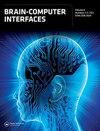Closed loop BCI system for Cybathlon 2020
IF 2.1
Q3 ENGINEERING, BIOMEDICAL
引用次数: 1
Abstract
We developed a Brain-Computer Interface (BCI) System for the BCI discipline of Cybathlon 2020 competition, where participants with tetraplegia (pilots) control a computer game with mental commands. To extract features from one-second-long electroencephalographic (EEG) signals, we calculated the absolute of the Fast-Fourier Transformation amplitude (FFTabs) and introduced two methods: Feature Average and Feature Range. The former calculates the average of the FFTabs for a specific frequency band, while the later generates multiple Feature Averages for non-overlapping 2 Hz wide frequency bins. The resulting features were fed to a Support Vector Machine classifier and tested on the PhysioNet database and our dataset containing 16 offline experiments recorded with the help of 2 pilots. 27 gameplay trials (out of 59) with our pilots reached the 240-second qualification time limit, which demonstrates the usability of our system in real-time circumstances. We critically compared the Feature Average of canonical frequency bands (alpha, beta, gamma, and theta) with our suggested range30 and range40 methods. On the PhysioNet dataset, the range40 method combined with an ensemble SVM classifier significantly reached the highest accuracy level (0.4607), with a 4-class classification; moreover, it outperformed the state-of-the-art EEGNet.2020 Cybathlon闭环BCI系统
我们为Cybathlon 2020比赛的BCI学科开发了脑机接口(BCI)系统,四肢瘫痪的参与者(飞行员)通过心理命令控制电脑游戏。为了从1秒长的脑电图(EEG)信号中提取特征,我们计算了快速傅立叶变换幅度(FFTabs)的绝对值,并引入了特征平均(Feature Average)和特征范围(Feature Range)两种方法。前者计算特定频带的FFTabs的平均值,而后者为不重叠的2hz宽频带生成多个Feature average。得到的特征被输入到支持向量机分类器中,并在PhysioNet数据库和我们的数据集上进行测试,其中包含16个离线实验,由2个飞行员记录。我们的飞行员进行了27次玩法试验(共59次),达到了240秒的资格时间限制,这证明了我们的系统在实时环境中的可用性。我们将典型频带(alpha、beta、gamma和theta)的Feature Average与我们建议的range30和range40方法进行了严格的比较。在PhysioNet数据集上,range40方法结合集成SVM分类器显著达到最高的准确率水平(0.4607),达到4类分类;此外,它的性能优于最先进的EEGNet。
本文章由计算机程序翻译,如有差异,请以英文原文为准。
求助全文
约1分钟内获得全文
求助全文

 求助内容:
求助内容: 应助结果提醒方式:
应助结果提醒方式:


